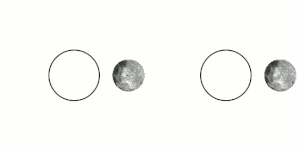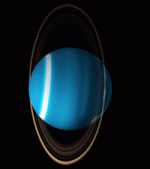The difference between my words and your words is that you stick to the data known and given by scientists and astronomers.. while I want to doubt
SOME of such data:
E.g. you said: Moon is tidally locked... I said:
why will Moon do this? You said: it completes one circle around the earth as it completes spinning around itself.
See, therefore, you didn't actually answer this point.
So why is the moon tidally locked as they call it!?
Again you came to assert the words of astronomers: Mercury and Venus are NOT tidally locked.
So you tell me something that I know astronomers say.
The interpreter tells people: look to Moon, Mercury, and Venus why do they behave as such different from other objects in the solar system?
the reason for the revolution of the planets around the sun
Gravity from Earth pulls on the closest tidal bulge, trying to keep it aligned. This creates tidal friction that slows the Moon's rotation. Over time, the rotation was slowed enough that the Moon's orbit and rotation matched, and the same face became tidally locked, forever pointed toward Earth.
The image on the left shows how the Moon moves about Earth, spinning on its axis once for each orbit. The image on the right shows what it would look like if the Moon didn't spin on its axis: different faces of the Moon would face Earth at various times....

Mercury IS tidally locked but in a different way to the Moon. For every three spins on it axis it does two rotations around the Sun.
Venus isn't tidally locked but is upside down, which means it is rotating backwards, like Uranus.
The Moon isn't the only moon in the Solar System that is tidally locked. These are, too:
These moons of Mars: Phobos, Deimos
These moons of Jupiter: Metis, Adrastea, Amalthea, Thebe, Io, Europa, Ganymede, Callisto
These moons of Saturn: Pan, Prometheus, Atlas, Pandora, Epimetheus, Janus, Mimas, Enceladus, Telesto, Tethys, Calysto, Rhea, Dione, Titan, Iapetus
These moons of Uranus: Umbriel, Miranda, Ariel, Titania, Oberon
These moons of Neptune: Proteas, Triton
This moon of Pluto: Charon
Pluto is also tidally locked to Charon.
These moons MAY be tidally locked to their planets but isn't yet known for sure:
These moons of Saturn: Daphnis, Aegaeon, Methone, Anthe, Pallene, Helene, Polydeuces
These moons of Uranus: Cordelia, Ophelia, Bianca, Cressida, Desdemona, Juliet, Portia, Rosalind, Cupid, Belinda, Perdita, Puck, Mab
These moons of Neptune: Naiad, Thalassa, Despina, Galatea, Larissa
So our Moon isn't the only moon that's tidally locked and always has the same face facing its planet. There are many others.




